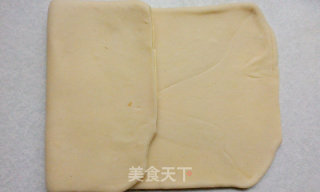Cheese Bacon Croissant
1.
Weigh the ingredients and put all the ingredients except milk and butter in a basin. Be careful not to contact the yeast directly with sugar or salt.
2.
Add milk a little bit to make a slightly firmer dough (I originally weighed out 60 grams of milk, and used 55 grams according to the state of the dough at the time)
3.
Beat and knead, the dough has a certain degree of ductility, when the surface is already relatively smooth, add butter
4.
Knead the butter into the dough and continue to beat the dough until it is close to the expansion stage. Be sure not to knead it, otherwise, it will be difficult to roll it out in the next steps
5.
Take a small piece of dough and test the ductility of the dough without going to the expansion stage
6.
Immediately roll the dough into square slices and put it in the freezer of the refrigerator for more than 30 minutes
7.
Cut the butter into slices, put it in a fresh-keeping bag, beat it into square slices with a dough roll, and pack it into the dough in a cross method
8.
Sprinkle a little high-gluten flour on the surface of the dough to prevent it from sticking, use a dough roll to roll out a large rectangular dough sheet
9.
Cut off the left and right ends of the dough sheet and cut it until the butter wrapped inside is exposed. The structure will be better. Fold the left end of the dough sheet by one third, and fold the right sheet over. Freeze in the refrigerator for 20 minutes to prevent fermentation, then put it in the refrigerator to relax for 30 minutes, do the second three-fold, then continue to freeze
10.
Take out the second and third-folded dough from the refrigerator compartment, roll it out, and put 30 grams of mozzarella cheese and cut into small pieces of bacon. Fill up two-thirds of the dough
11.
Complete the third three-fold discount and continue to freeze and refrigerate. Take out the dough and roll it out. Because of the sinking, the tissues will stick together, the cheese will melt, and the size of the holes will be uneven, or there will be large holes.
12.
After rolling into 4mm thick dough, use a sharp knife to cut the dough. Equilateral triangle with a base of 7 cm and a height of 16 cm
13.
Roll from the bottom, press the small sharp corners under the dough
14.
Put it on a baking tray lined with greased paper, brush a layer of egg liquid, and ferment. The fermentation temperature must not be high. The melting point of ordinary butter is low. It is better to have a lower temperature and a longer fermentation time than fast. Mine was basically at a room temperature of 20 degrees, and it took 3 and a half hours
15.
After the fermentation is complete, brush a layer of egg liquid on the surface, preheat the oven to 200 degrees, bake for 15 minutes, then turn to 180 degrees, and bake for about 5 minutes.
Tips:
1. The croissant is very delicate. You must be patient and careful to make the croissant. If you want the final size of the holes in the tissue to be uniform, you must evenly roll the butter slices into the dough.
2. The final fermentation is also very critical. All the previous steps are okay. It is likely that the final fermentation temperature will be too high, the butter will melt or the fermentation will not be in place, and it will fall short. If there is no fermentation tank, it can be fermented at room temperature, but the fermentation time will be different. Longer. Before fermenting, apply egg liquid on the surface of the croissant
























